How to Use Marketing Strategies for Consultants to Stand Out in 2025
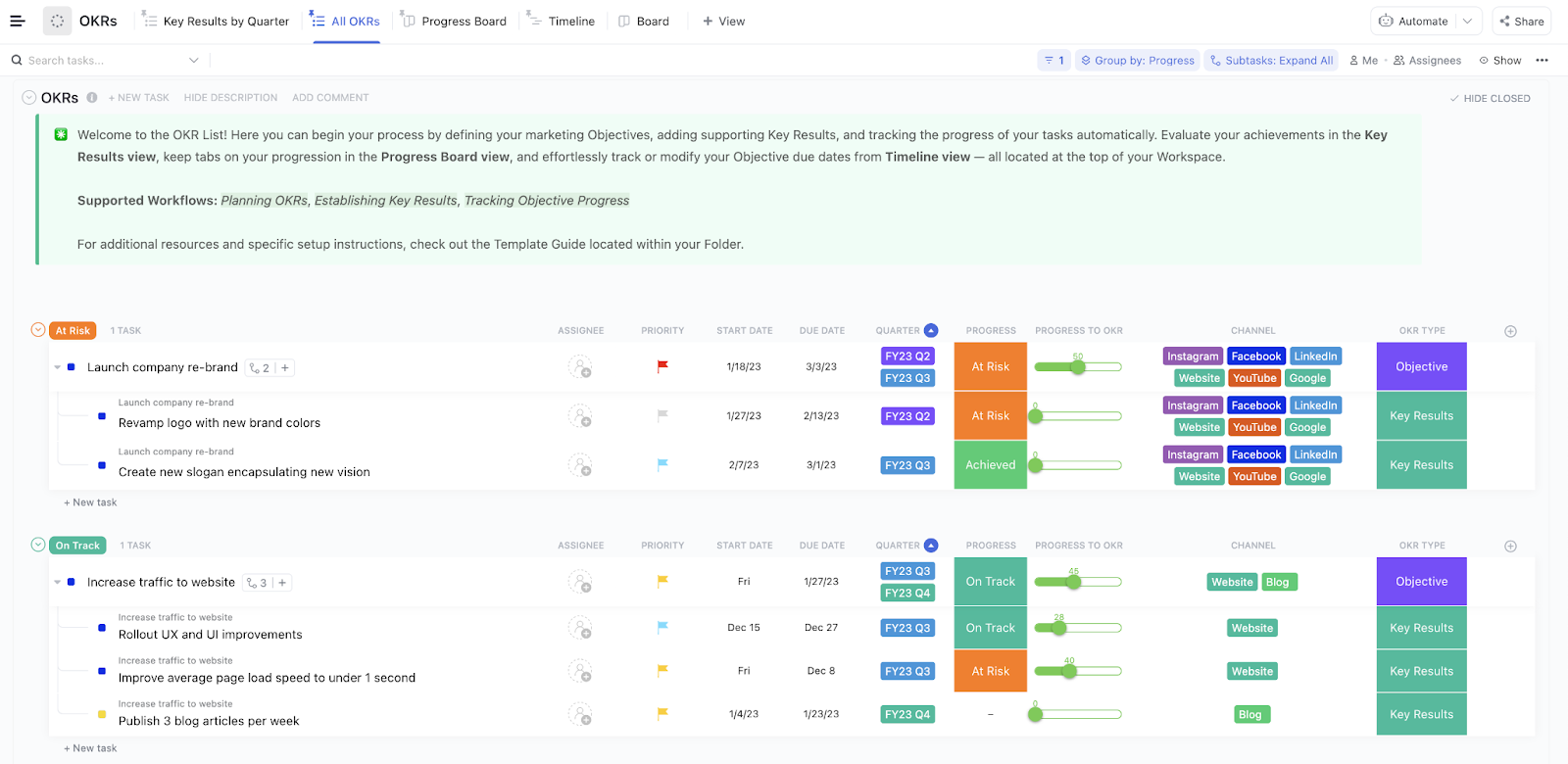
Sorry, there were no results found for “”
Sorry, there were no results found for “”
Sorry, there were no results found for “”

Still relying on swipe files and cold DMs to generate business? You may want to reconsider.
In a world where prospective clients do the bulk of their research before ever responding to outreach, that’s a risky bet. Clients are tuning in to how you think—on LinkedIn, in podcasts, in case studies.
They’re judging how precise your offer is. They’re saving content that speaks directly to their problems.
So the game has changed, and the consulting business today has evolved beyond mindlessly spamming inboxes or online advertising. It’s about showing up with insight that builds trust at scale.
In this guide, you’ll learn how to do precisely that, with innovative marketing strategies and software tools for consultants to attract the right new clients and retain past clients, without chasing them.
Want to build a consistent pipeline of leads? The ClickUp Consulting Firm Marketing Plan Template is a beginner-friendly, ready-to-use tool designed to help consultants define their target audience, plan marketing campaigns, and easily track KPIs.
With built-in Custom Statuses, Custom Fields, and views like Key Results and Progress Board, it offers a clear roadmap for executing SEO, content, and social strategies.
Consulting is a relationship-driven business, but relationships don’t grow in isolation. Here’s why marketing is vital to help you stand out, build credibility, and build relationships while attracting the right clients:
👀 Did You Know? The Big Four—Deloitte, PwC, EY, and KPMG—all started as small accounting firms in the 1800s. Over time, they evolved into global consulting powerhouses, now shaping everything from corporate strategy to regulatory frameworks.
The key to consulting success is not doing more marketing but more focused, evidence-backed, and category-defining marketing. Here are some tried and tested strategies to make that shift in your target market:
Prospective clients don’t want to decode your process. They’re simply looking for clarity. Packaging your service as a named offer with a clear scope, timeline, and promised outcome makes it easier for them to say yes. It builds trust with current clients too, sets boundaries, and accelerates your sales cycle.
📌 Example: Instead of saying “I do operations consulting for startups,” turn your offer into “The 30-Day Workflow Reset.”
Break it into phases of targeted strategies:
Promise a tangible result: “Cut internal delays by 40%—or your money back.” Include this in a one-pager with deliverables, FAQs, and pricing tiers.
💡 Pro Tip: Use ClickUp Docs to break each productized offer into clear milestones, delivery steps, and metrics. Include FAQs, pricing tiers, and client onboarding checklists. Treat it like a micro-product with a repeatable delivery engine behind it.
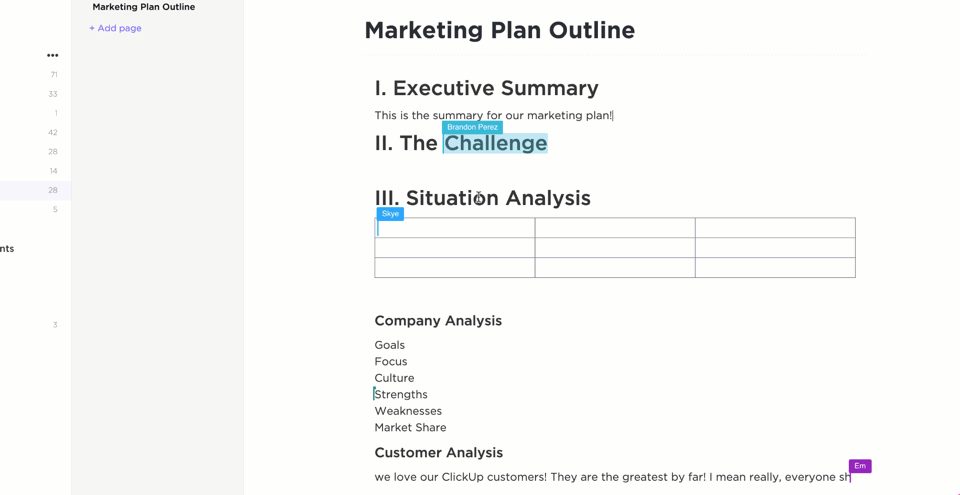
Saying you’re a “sales consultant” or “field marketing strategist” may be too vague in today’s environment. Buyers want specialists who understand their niche, growth stage, and unique operating context. You must position yourself in a narrow, well-defined sub-category where your expertise becomes immediately relevant, distinguishing you from other consultants.
Specializing gives people a reason to remember you. It turns you into a category of one instead of just another option.
📌 Example: If you help early-stage SaaS teams fix go-to-market problems, brand yourself “The GTM Scalability Coach for SaaS Founders Between Series A and B.” This signals that you understand their exact pain points—like founder-led sales plateaus, unclear handoffs, and messy CRM setups.
💡 Pro Tip: For quick implementation, rework your LinkedIn headline, your homepage tagline, and your first five minutes of a discovery call to reflect this specific positioning. Make it clear what exact transformation you help deliver and for whom.
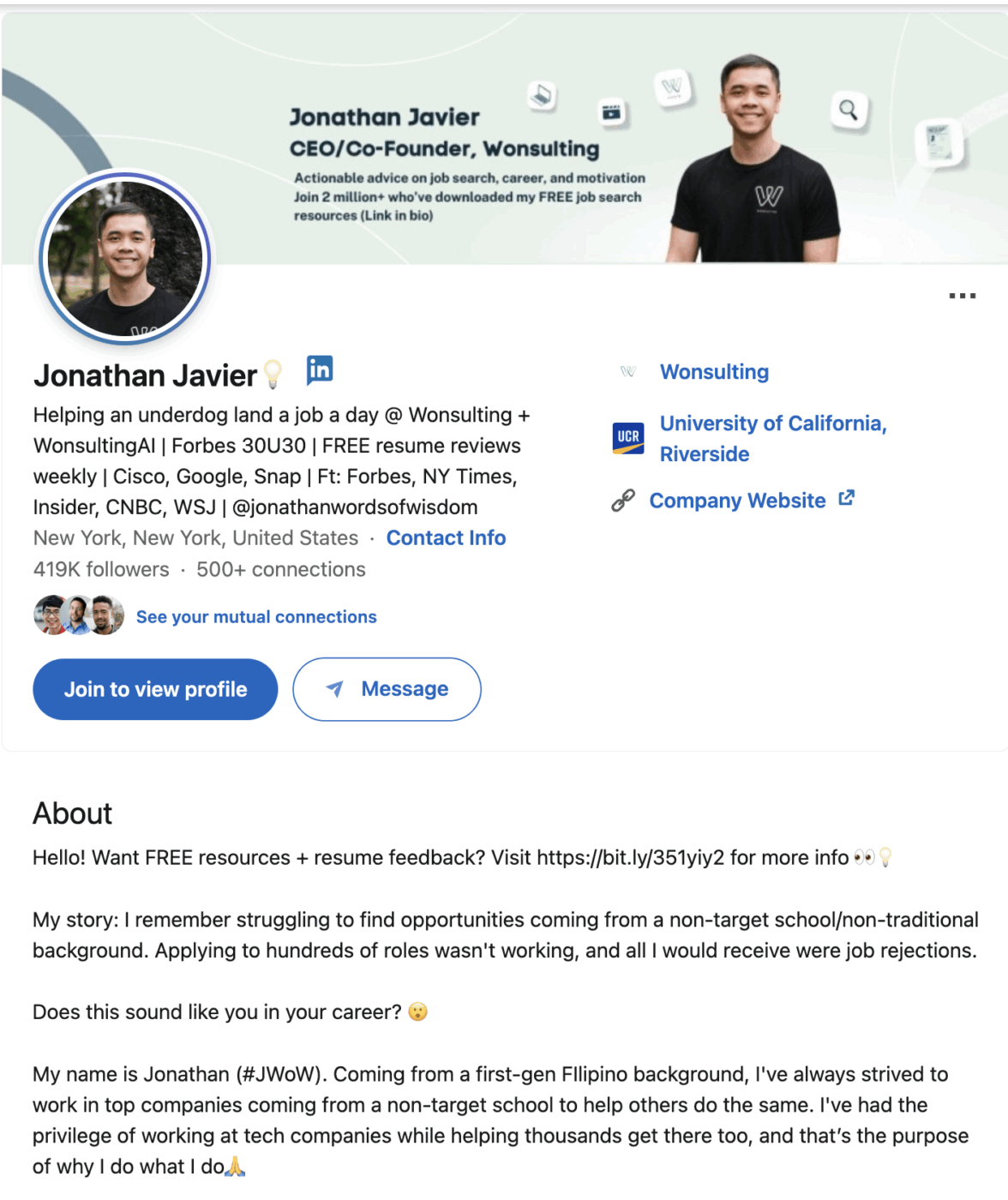
He differentiates himself by saying:
My and Wonsulting’s mission is “to turn underdogs into winners”. I’ve spoken in 9 countries and 250+ universities/organizations, providing insights from my own findings to help people get into their dream careers.
Generic thought leadership doesn’t convert. Consultants struggle to understand this. But what converts and gives immediate value? A distinct, well-defended point of view that shapes how people see a common problem. The most effective consultants use their content to educate and differentiate. And they do it consistently across platforms.
Sharing tips is easy. Taking a stand? That’s what gets remembered. Take one strong thesis, build a series of content assets around it, and let that ecosystem demonstrate your strategic thinking in action.
📌 Example: If your belief is: “Most DEI initiatives fail because HR departments lead them in isolation,” that idea becomes your north star.
You could create:
🌼 Real-life example: Future Cain, a health and wellness practitioner based in the US, is known for the unique mental health perspective she brings into leadership trainings with her concept, social emotional intelligence. Her Instagram and LinkedIn reels showcase relatable, hard-hitting content that gets right to the point!
Consulting isn’t sold in one step. It requires educating your buyer, showing them their blind spots, and leading them to a decision, all while building trust. One of the most effective ways to do this is by turning a core client insight into a three-part funnel.
Start with a high-value, diagnostic-style lead magnet. Then nurture that audience with a short, sequenced email series that walks them through the issue’s ripple effects. Finally, offer a focused service that solves exactly that problem.
📌 Example: Let’s say you’ve noticed that many leadership teams are stuck because no one’s really clear on who owns what decisions. This creates friction, delays, and passive bottlenecks—but no one names it.
You turn this into a three-part funnel:
By the time they finish this funnel, they don’t just understand the problem—they feel the drag it’s causing and are ready to eliminate it.
🧠 Fun Fact: Marketing consultants once used door-to-door cookbooks. Long before email, Jell-O gave away cookbooks in the early 1960s to help home cooks—an early form of content marketing that consulting firms later scaled via thought leadership
Webinars are often underutilized or overproduced, especially in the consulting world. The most effective webinars are short, tactical, and aimed at solving one problem for a tightly defined audience. Skip the high-level fluff and walk participants through a specific solution they can use immediately.
Give them real marketing campaign templates, dashboards, or workflows. Make it feel like a preview of what it’s like to work with you.
📌 Example:
Host a session titled “Fix Your Internal SLA Bottlenecks Using ClickUp” targeting Heads of Enterprise Marketing Operations. Walk through a real broken workflow and show how you improved it live. Keep it to 25 minutes, follow with Q&A, and then offer a free systems audit to qualified attendees.
Post-event, chop the recording into LinkedIn clips and turn FAQs into email content. One webinar = one month of content + leads.
ClickUp’s secret supper initiative is a great example of highly curated events!
I am grateful for my invitation to attend ClickUp‘s Secret Supper Sydney with my colleague Claire Vu. This was an unforgettable evening of networking and culinary delights at the Quay Restaurant, overlooking the stunning Sydney Opera House and Harbour Bridge.
We kicked off the dinner with a group toast to productivity. I was particularly impressed by the “Exec Suite Hot Seat” interviews, where industry experts shared their insights, and the ClickUp Solutions Architect demo showcased the latest productivity solutions innovations.
There’s no faster way to build visibility than to align yourself with platforms, SaaS tools, or niche ecosystems your ideal client already trusts. Rather than doing outreach cold, you embed yourself into their existing workflow or content stream.
These partnerships don’t always need to be formal. They can include guest workshops, resource swaps, or plug-in consulting services extending the partner brand’s core value.
📌 Example: If you’re a digital operations consultant, partner with a cybersecurity SaaS company and offer Post-Breach Process Audits for their customers. They get increased retention and product adoption—you get qualified leads and co-branded exposure. Even a guest post or webinar can embed you deep into the partner’s funnel.
Clients today are not just looking for you to demonstrate expertise. They want to understand how you think. A “backstage pass” content format gives your audience a consistent window into your methodology, making your decision-making and tools feel more familiar before they ever become a client.
This format can be a recurring weekly video, newsletter, or post showing how to fix problems in real time. Not abstract theory, but concrete decision breakdowns, system audits, or project reviews.
📌 Example: Start a weekly newsletter or video series called “Monday Systems Fix.” Break down a messy delegation chain, a broken campaign setup, or a misaligned team process. Explain how you’d fix it and why.
Post clips on LinkedIn and invite subscribers to request their own teardown. This positions you as both teacher and expert, before they even get on a call.
👀 Did You Know? Iconic business tools like SWOT analysis were developed or brought to the mainstream by leading management consulting firms.
Clients are becoming skeptical of claims. Telling them you improved efficiency or aligned the team isn’t enough anymore. Show them exactly what changed. Use visual evidence—before-and-after screenshots, dashboards, or real KPIs—to make the transformation tangible.
📌 Example:
Instead of writing “We improved task visibility for the team,” show two dashboards:
Instead of asking for praise, ask for stories. When a client talks about their situation before, their frustrations, what they tried and failed, and the specific turning point when your work changed the outcome, that creates relatability. Prospects see themselves in those stories and mentally opt in.
📌 Example:
“After two failed attempts to scale ops post-Series A, our SaaS team was overwhelmed. Within six weeks, [your name] implemented a decision-making matrix, redesigned our team workflows, and helped us 3x our roadmap delivery. I finally feel like we’re operating as one team.”
Use this story format in your case studies, social proof, or sales emails. Structure it like: Before → Tried & Failed → Intervention → Outcome → Advice to Others.
📮 ClickUp Insight: 24% of workers say repetitive tasks prevent them from doing more meaningful work, and another 24% feel their skills are underutilized. That’s nearly half the workforce feeling creatively blocked and undervalued. 💔
ClickUp helps shift the focus back to high-impact work with easy-to-set-up AI agents, automating recurring tasks based on triggers. For example, when a task is marked as complete, ClickUp’s AI Agent can automatically assign the next step, send reminders, or update project statuses, freeing you from manual follow-ups.
💫 Real results: STANLEY Security reduced time spent building reports by 50% or more with ClickUp’s customizable reporting tools—freeing their teams to focus less on formatting and more on forecasting.
Instead of trying to convince prospects that they need your help, let them persuade themselves. Diagnostic tools like readiness checklists, marketing playbooks, self-assessments, or ROI calculators shift the conversation from persuasion to discovery.
These tools position you as an expert while helping the client uncover problems they didn’t realize were urgent. Done right, they make your services the next logical step.
📌 Example: Build a tool like “The Team Alignment Scorecard”—a 10-question quiz that reveals how misaligned ops, product marketing strategy, and leadership teams really are. Based on their score, recommend your Leadership Sync Sprint and offer a free consulting marketing strategy call. It shifts the energy from selling to solving.
Running marketing as a consultant means constantly switching gears—from big-picture planning to daily execution—while keeping every client in the loop and every deliverable on track.
ClickUp, the everything app for work, gives you one unified space to manage all of that. And it’s not just packed with features. It’s built to match how you work, with flexibility that feels personal.
Let’s show you how ClickUp for Marketing can help elevate your strategies.
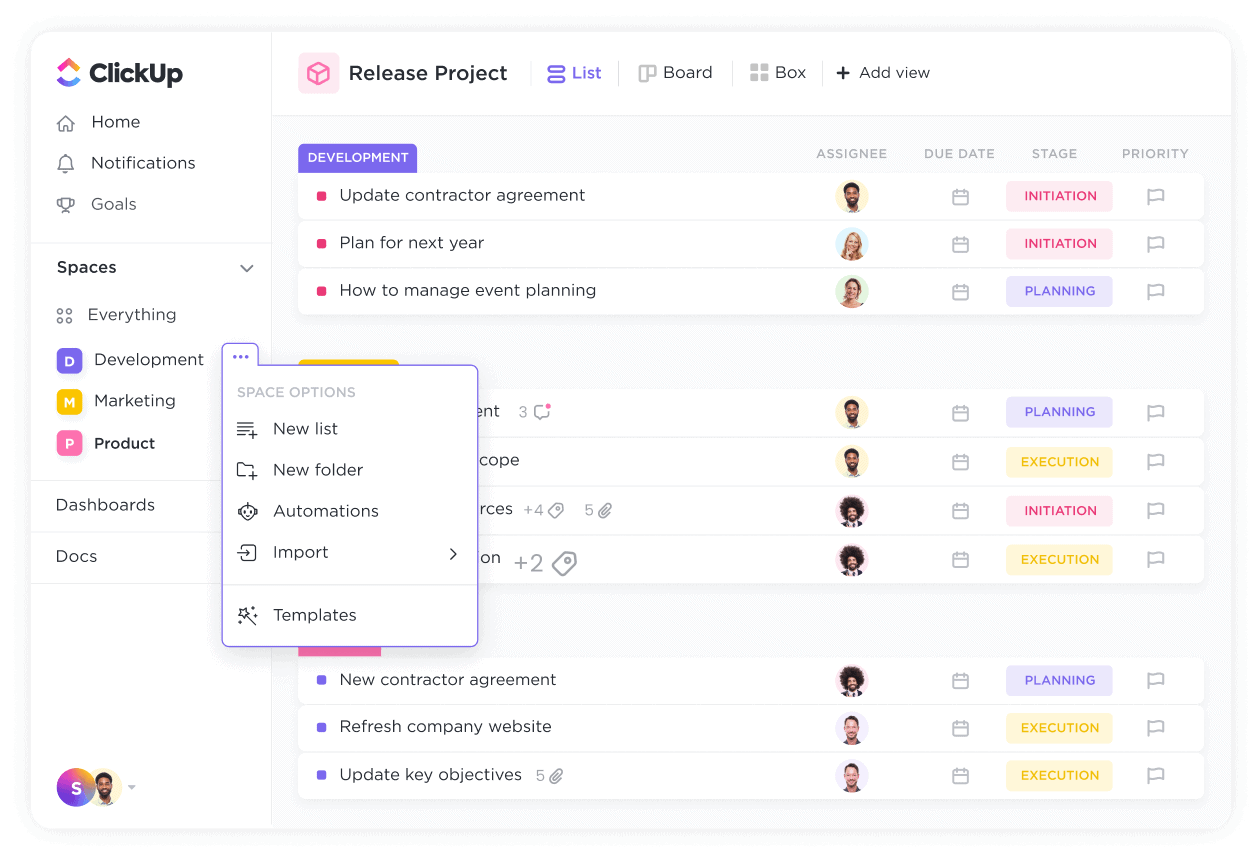
Without a clear system, campaigns get messy fast. Start by using ClickUp Spaces to organize work by functional teams or clients. For instance, you can have a dedicated Marketing Space just for marketing work.
Inside, you can create Folders for major functions like Content Marketing Management, Paid Media Analysis, and Brand Campaigns Visibility. Within each Folder, Lists break actual tasks (writing copy, designing creatives, building landing pages, and more) even further, like a “Q3 LinkedIn Campaign” List inside the Social Media folder.
Each List can house the actual tasks: writing copy, designing creatives, and building landing pages.
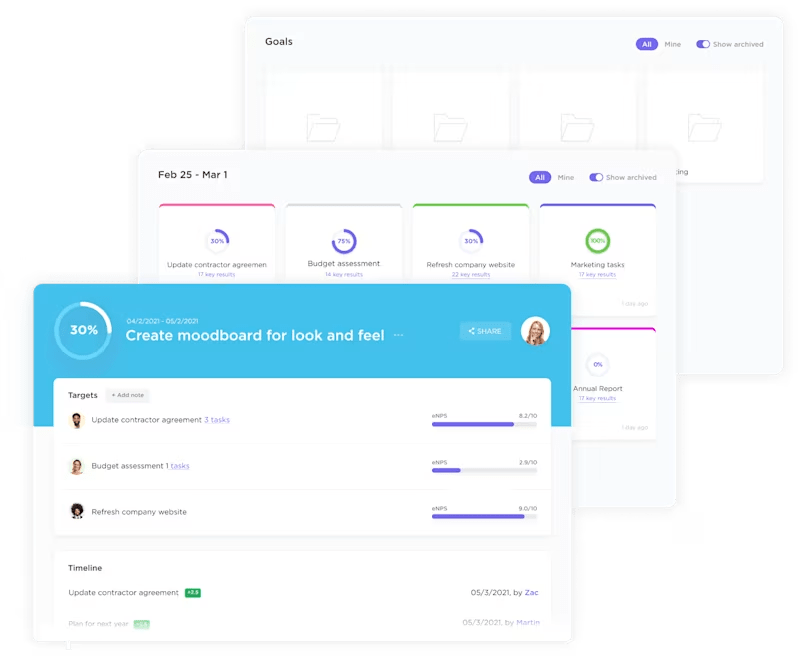
Your marketing output must be measurable, and ClickUp Goals helps you do exactly that. Say a client wants to grow webinar signups by 30% this quarter. You can set that up as a measurable goal, link it directly to tasks like landing page creation, email promos, and ad spend approvals, and track live progress across all workstreams.
By using ClickUp, you can drive growth as you always know what’s moving the needle—and so does your client.
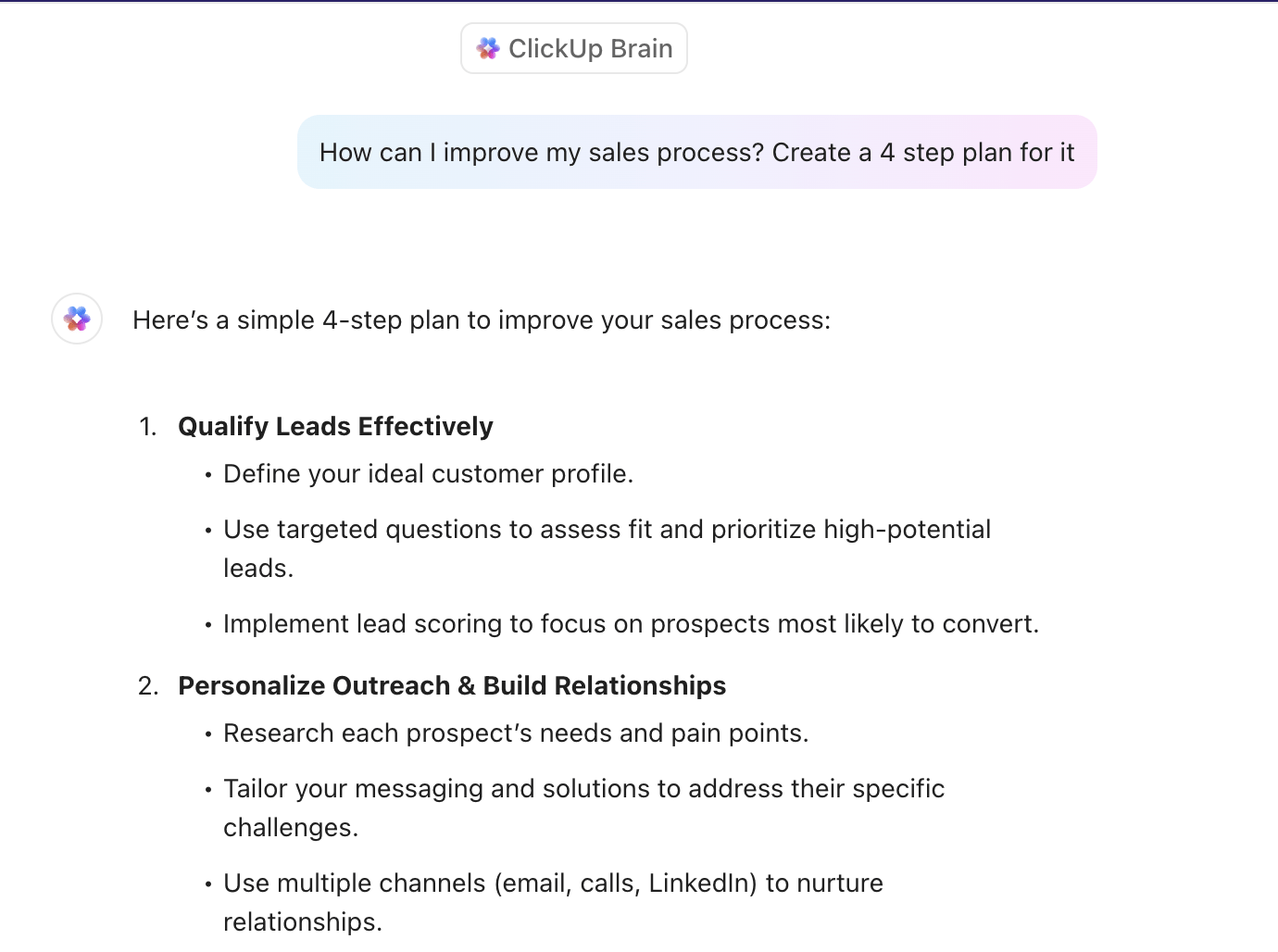
When you’re in a rush (and let’s be honest, that’s often), ClickUp Brain—the platform’s in-built AI assistant—becomes your behind-the-scenes content strategist.
Need to generate blog post outlines, summarize consulting meetings, or rewrite ad copy based on tone guidelines? Brain does it inside your tasks and Docs, keeping everything within your ClickUp Space. You can even access multiple LLMS within Brain for your varied marketing tasks!
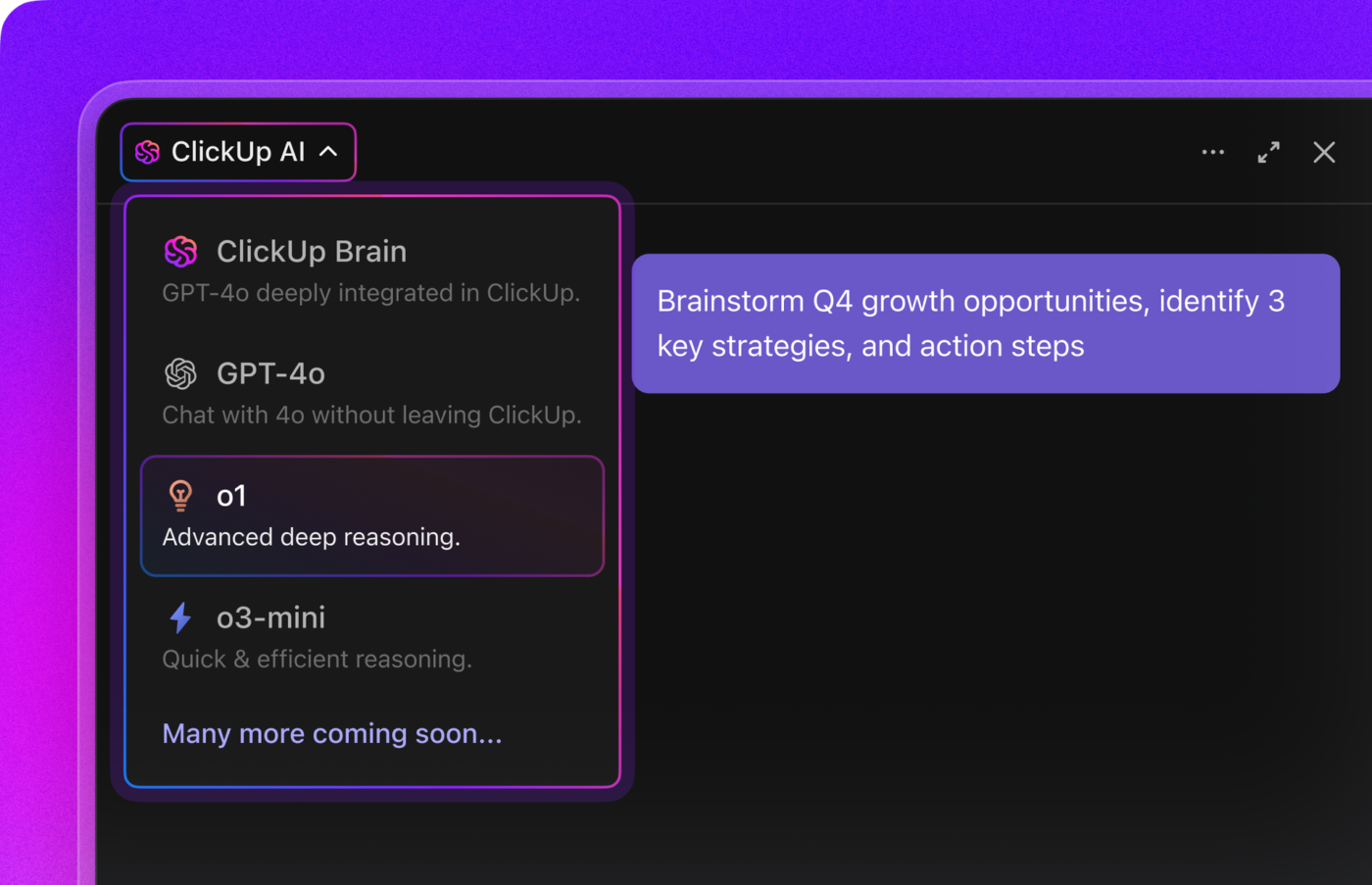
Highlighting the key advantages of ClickUp Brain for marketing, Yvi Heimann, Business Efficiency Consultant, says:
We have been able to cut in half the time spent on certain workflows by being able to generate ideas, frameworks, and processes on the fly and right in ClickUp.
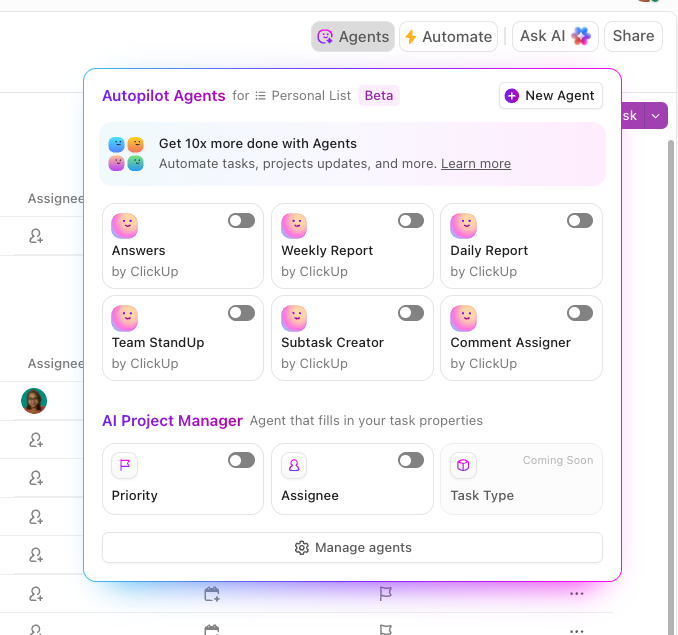
ClickUp Automations is where your sanity gets saved. Instead of wasting time on admin, you can automate things like sending a Slack message when tasks hit “Needs Review,” or assigning client feedback subtasks when you get their email. It’s ideal for those recurring processes you’d rather not handle repeatedly.
📚 Also Read: Best Consulting Strategies to Grow Your Business
Not starting from scratch every time you reach out to clients can strengthen your marketing productivity metrics. After all, time saved is time reclaimed.
The ClickUp Strategic Marketing Plan Template is fully loaded with Custom Statuses to match real-world workflows like “Initial Research,” “Draft Strategy,” “Client Review,” and “Final Approval.”
Paired with Board View, you get a drag-and-drop flow to visually manage high-level growth marketing strategy development. Flip to the Doc View for the planning narrative, or Timeline View to keep stakeholders aligned on deliverables across weeks.
When you’re in campaign execution mode, you need to try the ClickUp Marketing Campaign Management Template.
It includes Custom Statuses like “Briefing,” “In Production,” “QA,” “Scheduled,” and “Live,” so you can track creatives across every touchpoint. Need to filter assets by client, region, or team? Use List View or Calendar View to slice your data how you want.
You can even set up a Gantt View for bigger launches that require tight coordination across functions.
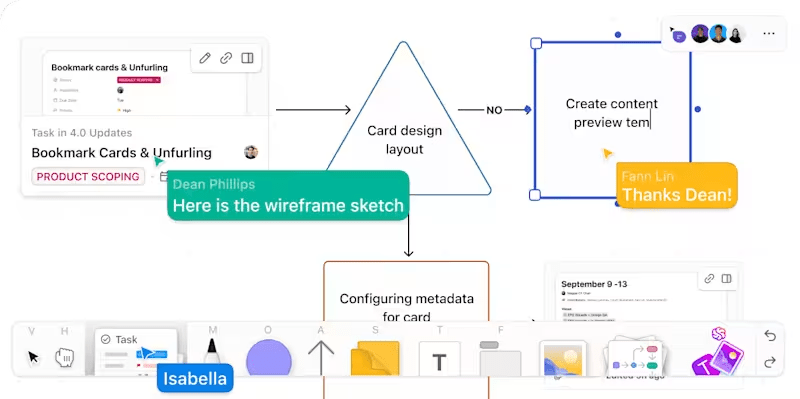
For idea-heavy work like planning a brand pivot or mapping out a customer journey, ClickUp Whiteboards is your secret weapon. It lets you sketch your thinking visually, connecting thoughts to actionable plans.
The best part? You can turn your ideas into tasks and assign them right from the board—all while keeping your remote and in-office team on the same page.

And when you need to tie it all together in a client-facing and polished way, ClickUp Dashboards help you build live reporting panels. Show how many campaigns are in production, how close you are to monthly goals, or track conversion trends—no need to pull a last-minute report again.
This setup—Goals, Brain, Automations, Templates with Custom Views and Statuses—gives you complete control over your marketing process. You’ll deliver work faster, collaborate better, and build long-term client trust, all while making your day-to-day more manageable.
Even the most seasoned consultants can fall into marketing traps that cost time, trust, and traction. Here’s a clear list of typical marketing errors consultants make and specific solutions for each.
| Where are you missing the mark? | Why is it a problem? | Solution |
| Trying to appeal to everyone | Broad messaging fails to attract ideal clients and weakens positioning | Define a clear niche and tailor your messaging to a specific industry, problem, or audience |
| Relying only on referrals | Referrals can dry up and aren’t scalable | Invest in content marketing, SEO, LinkedIn outreach, or webinars to build a steady pipeline |
| Ignoring personal brand | An outdated or inconsistent online presence reduces credibility | Keep your professional website, social media presence, and case studies updated and aligned with your services |
| Overcomplicating the value proposition | Jargon and complexity confuse potential clients and delay decisions | Use simple, benefit-driven language that highlights outcomes, not just services |
| Neglecting performance tracking | Without data, you can’t improve or justify your marketing efforts | Set marketing KPIs and use tools like ClickUp Dashboards or Google Analytics to track what’s working |
| Marketing inconsistently | Sporadic efforts lead to missed opportunities and brand dilution | Create a marketing calendar and use templates or automation to stay consistent |
| Focusing only on the service, not the client’s problem | Leads to self-centered messaging that doesn’t resonate | Frame your offering around solving the client’s pain points and desired outcomes |
Think of the best consultants you know. Maybe it’s the strategist whose weekly newsletter always hits home, or the operations expert who built a killer free audit tool that keeps showing up in your feed. They didn’t leave their visibility to chance; they built systems around it to generate leads.
They didn’t just become consultants because they’re good at their work. They got known because they treated their marketing with the same care they bring to client work. That’s the real edge.
ClickUp helps make that possible. Map out your funnel in Whiteboards. Draft your playbooks and email marketing sequences in Docs. Use ClickUp Brain to turn rough ideas into content that sounds like you on a good day. With dedicated Spaces for marketing, sales, and delivery, your work stays connected—and so do you.
Ready to build a marketing engine that runs as well as your client work? Sign up for ClickUp and start turning strategy into action today.
© 2026 ClickUp